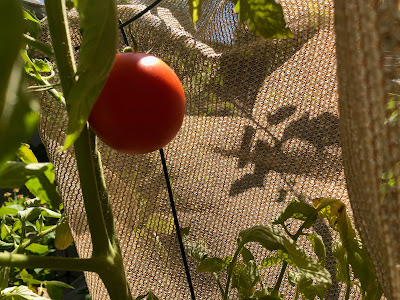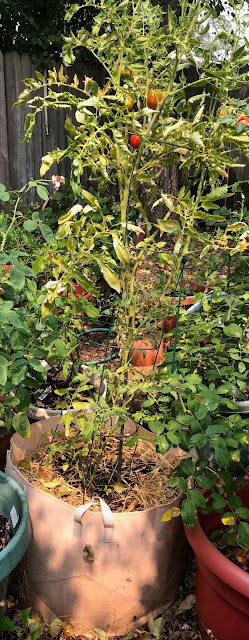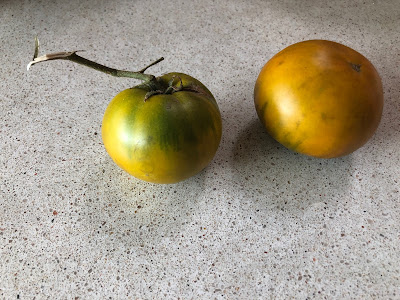
What can tomato growers learn from all this?

|
|
If there's one photo that sums up the 2020
growing season, it's this one: Tomato behind
shade cloth in mid-August. (Photos:
Kathy Morrison)
|
Warning! Today I'm going to explore a sensitive topic: The tomato-growing season of 2020.
What, you say, why remind us of all that anguish?
Well, it was a learning experience, that's for sure. Even gardeners who had good-to-great tomato seasons ran into a few bumps. (112 degrees!!!) And we all feel a little sad when we pull out that last tomato plant, but that doesn't mean we should immediately erase the season from memory.
As baseball fans like to say, wait 'til next year!
Looking ahead, the biggest concern is the increasing number of hot days. As Debbie reported Wednesday , we had a record 125 days of 90-degree (or hotter) weather. That's a full four months, folks, two weeks more than the previous record of 110 in 1984. We need to acknowledge this kind of summer heat probably is here to stay. It's no longer an aberration.

|
|
All in all, this Big Beef was
pretty happy in its 30-gallon grow pot.
|
-- Prep that soil as early as possible. Run a soil test in winter on the preferred tomato location. Add nitrogen, compost and worm castings early enough that the soil is ready when planting weather is right.
-- Which reminds me: Assuming it's not pouring rain for a month -- as if! -- plant at least a few tomatoes in late March or early April. Then roll out the rest over a month. If there are heat spikes in June, which is an increasingly good bet, at least some of the tomatoes will be producing.
-- Fight spider mites early and often. Spray everything down with water, including pathways, at least every other day as the weather starts to warm up, whether or not spider mites seem to be present. (They are, most likely.) The longer I kept them at bay, the better chance my tomato plants had to grow and produce.
-- Go after weeds early, too. My community garden plot is along a fence, and outside the fence is field and a ditch -- perfect hiding places for overwintering pests. I really need to attack the weeds along the fence early, before most of the summer garden is planted.
-- Put in even more pollinator plants. I typically have zinnias, sunflowers and an African blue basil plant near my vegetables. This year, I upped the pollinator options by adding alyssum, chamomile and fennel transplants, and I dumped an entire package of mixed basil seeds into a 2-foot spot. That basil was just for the bees and other beneficials -- I let it flower and it's still going strong. The good bugs get even more sources next year, definitely.
-- Have plenty of shade cloth on hand before the heat spikes. It was sold out in many places by July, when I realized I could use a LOT more of it. I improvised with a wrecked lace tablecloth and some towels, but shade cloth works for a reason: It's tough but permeable. It also can be rolled up and put away for next year. I even washed some of mine on delicate in the washing machine, and it came out fine.

|
|
These are a couple of the Green Cherokee tomatoes.
Interesting, but ultimately not worth the time commitment. |
-- Grow pots can work for tomatoes. This was another experiment for me this year: Would a full-size tomato produce in a 30-gallon fabric grow pot? It took a lot of potting soil and compost to fill that pot, but the Big Beef I put in it did pretty well, considering the weather. Also, I was home all the time to keep it watered. I also mulched it heavily with straw, and surrounded it with several potted roses to keep the soil from drying out too fast.
-- Grow Better Bush again. It's by far the best container plant I've tried, and it put up with the weather beautifully. Patio Yellow was another good one in a pot. Gee, I really need to check my seed supply, before I pack everything away and the tomato memories fade completely.
If any readers would like to share what they learned in tomato gardening this year, write to Debbie and me at sacdigsgardening@gmail.com.
Comments
0 comments have been posted.Sacramento Digs Gardening to your inbox.
Sites We Like
Garden Checklist for week of April 21
This week there’s plenty to keep gardeners busy. With no rain in the immediate forecast, remember to irrigate any new transplants.
* Weed, weed, weed! Get them before they flower and go to seed.
* April is the last chance to plant citrus trees such as dwarf orange, lemon and kumquat. These trees also look good in landscaping and provide fresh fruit in winter.
* Smell orange blossoms? Feed citrus trees with a low dose of balanced fertilizer (such as 10-10-10) during bloom to help set fruit. Keep an eye out for ants.
* Apply slow-release fertilizer to the lawn.
* Thoroughly clean debris from the bottom of outdoor ponds or fountains.
* Spring brings a flush of rapid growth, and that means your garden is really hungry. Feed shrubs and trees with a slow-release fertilizer. Or mulch with a 1-inch layer of compost.
* Azaleas and camellias looking a little yellow? If leaves are turning yellow between the veins, give them a boost with chelated iron.
* Trim dead flowers but not leaves from spring-flowering bulbs such as daffodils and tulips. Those leaves gather energy to create next year's flowers. Also, give the bulbs a fertilizer boost after bloom.
* Pinch chrysanthemums back to 12 inches for fall flowers. Cut old stems to the ground.
* Mulch around plants to conserve moisture and control weeds.
* From seed, plant beans, beets, cantaloupes, carrots, corn, cucumbers, melons, radishes and squash.
* Plant onion sets.
* In the flower garden, plant seeds for asters, cosmos, celosia, marigolds, salvia, sunflowers and zinnias.
* Transplant petunias, zinnias, geraniums and other summer bloomers.
* Plant perennials and dahlia tubers for summer bloom.
* Mid to late April is about the last chance to plant summer bulbs, such as gladiolus and tuberous begonias.
* Transplant lettuce seedlings. Choose varieties that mature quickly such as loose leaf.